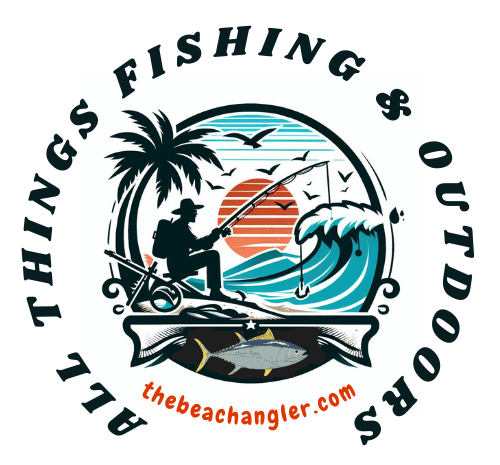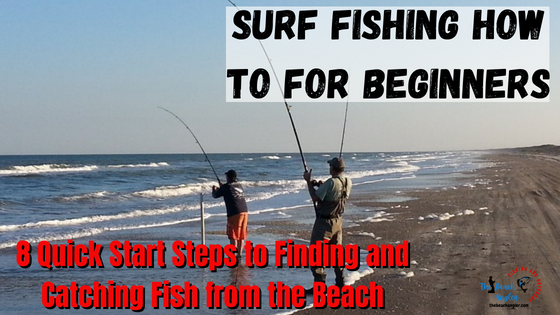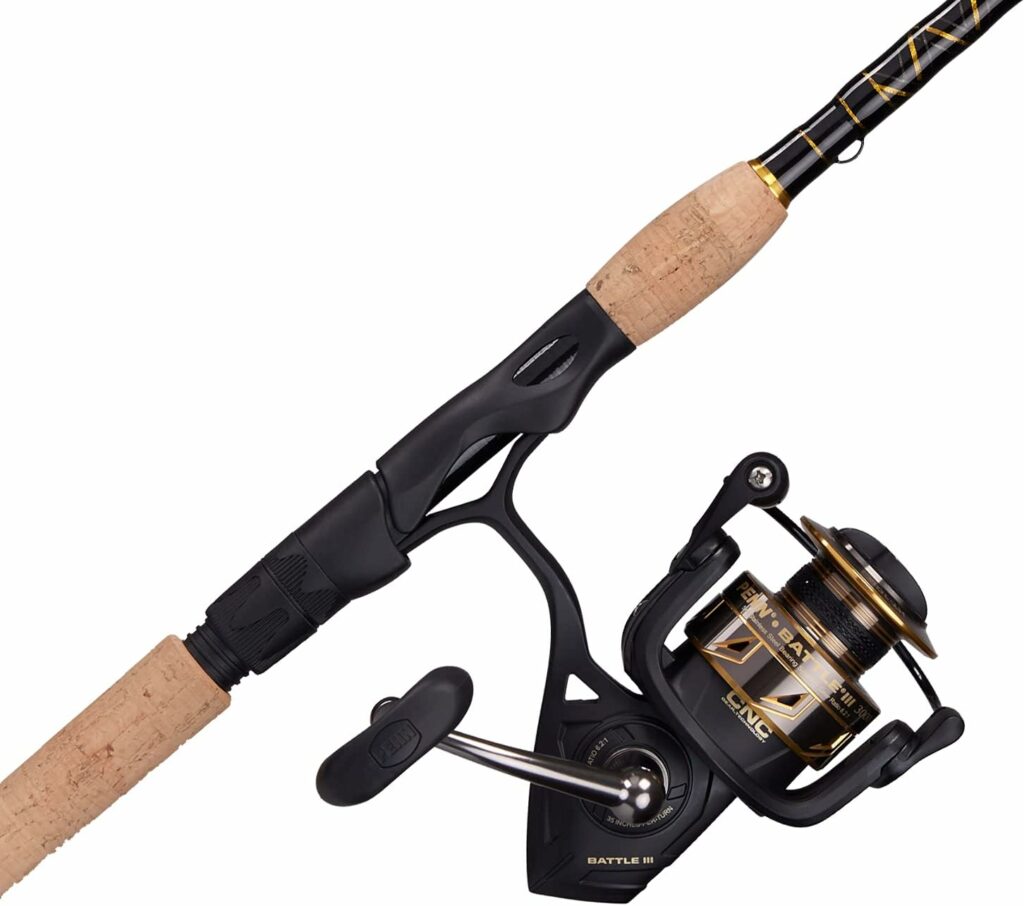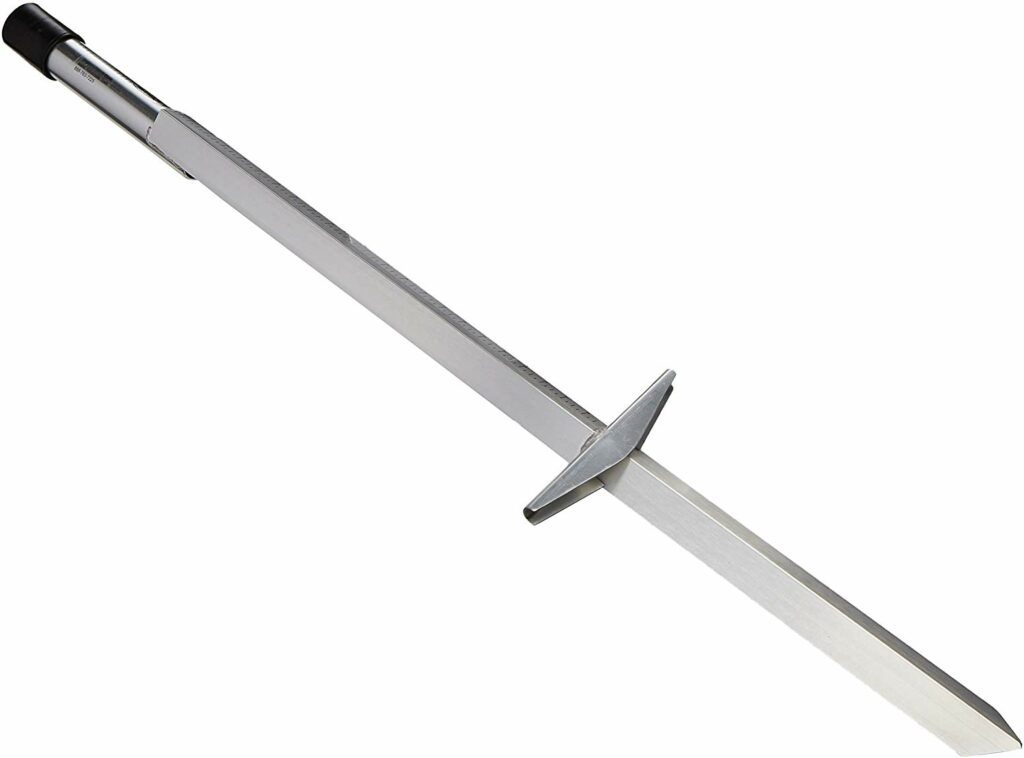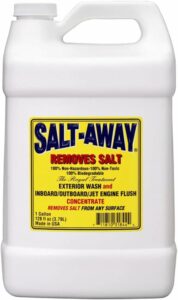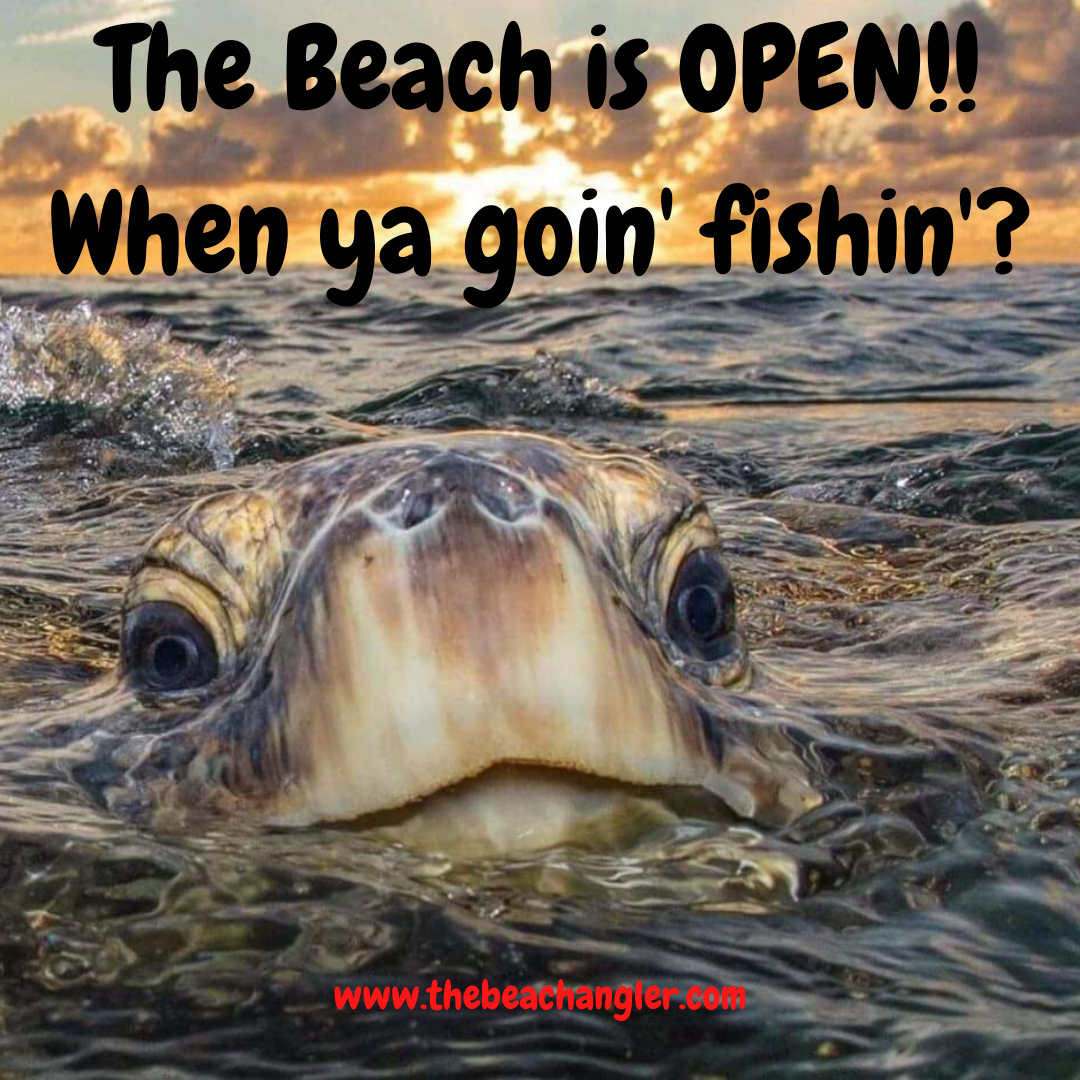If you’re looking for a fun and challenging way to catch fish, and enjoy spending time at the beach, surf fishing might be just what you need. This type of fishing involves casting your line from the beach into the ocean, and it can be a great way to target a variety of different species. It can also be a fun way for the whole family to enjoy a day on the beach. However, surf fishing for beginners, can seem a bit overwhelming.
Key Points
- Surf fishing is a challenging and exciting sport.
- To get started, you’ll need specialized equipment and knowledge of how to read the beach and water.
- Essential equipment for surf fishing includes a surf fishing rod, saltwater reel, lures, bait, and tackle.
- Surf fishing takes time and experience to learn.
- Surf fishing is a great way to spend a fun family day at the beach.
- Check with the locals for up to date information, and always practice “safety first” when surf fishing.
Don’t worry, if you don’t know where to start, come along and we’ll cover the basics with this surf fishing how to for beginners guide and give you some tips on how to get started. Now, I’ve been surf fishing for well over half a century now and have spent many a day fishing the beaches and I’m still learning. I’ve caught my fair share of fish along the way as well. Anyone can learn how to fish the surf, it’s not difficult but it does take some time and experience to get the hang of it.
The first thing you need to understand about surf fishing is that it requires some specialized equipment. You’ll need a surf fishing rod, which is longer and stronger than a typical freshwater rod, as well as a reel that can handle the corrosive effects of saltwater. You will also need a variety of lures, bait, and other tackle, depending on the species you’re targeting.
And, more importantly, you’ll need to know how to read the beach and the water in order to find the best spots to cast your line. Find the fish and you have half the battle won.
Let’s get to it and start with the basics of what exactly is surf fishing, why is special about it, and the gear, tips and strategies that will take you from a beginner to an “old salt” in no time.
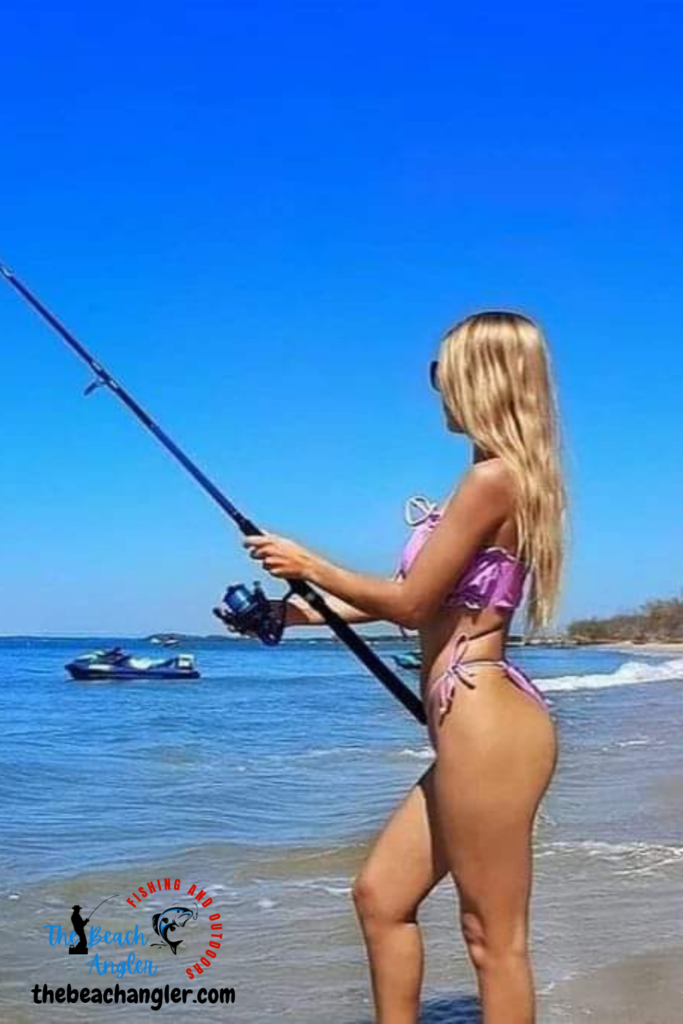
Understanding the Basics of Surf Fishing
What is Surf Fishing?
Surf fishing is a type of fishing that takes place on the beach or shore, where the angler casts their line into the breaking waves. It is a popular sport that can be enjoyed by anglers of all skill levels. Surf fishing is primarily done from the shore, but it can also be done from a boat or kayak. You can catch a wide variety of fish species, and where the shore meets the ocean, you never know what might take your bait.
Why is Surf Fishing Popular?
Surf fishing offers many benefits. First and foremost, it is a great way to spend time outdoors and enjoy the beauty of the beach. It is also a great way to catch a variety of fish, including striped bass, bluefish, surf perch, red drum, black drum, flounder, and many other species depending on where in the world you choose to try surf fishing.
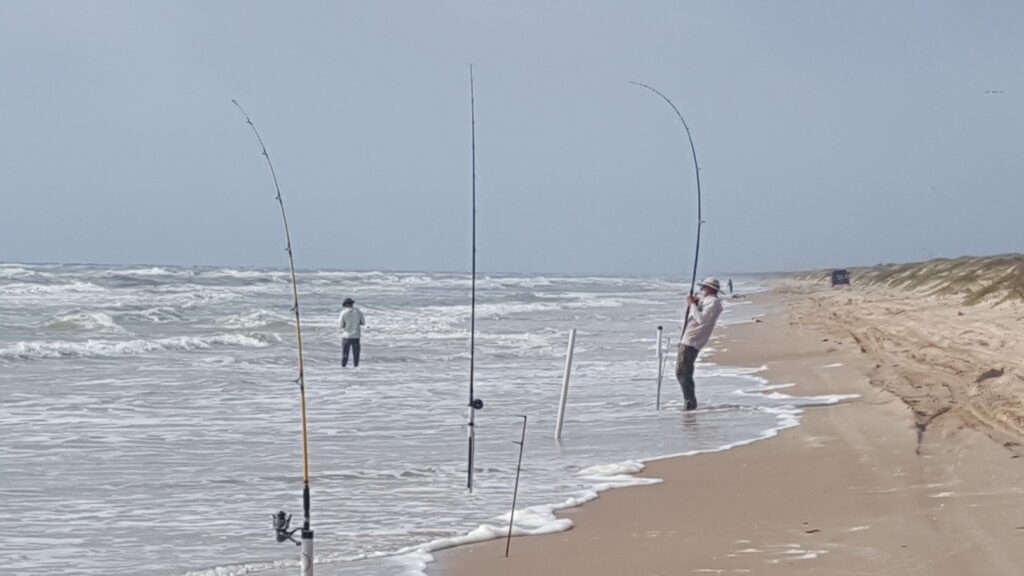
Surf fishing can also be a great way to get some exercise. Walking up and down the beach, wading out to cast your line, and reeling in your catch can be a great workout.
Additionally, surf fishing can be a very relaxing activity, as the sound of the waves and the feel of the sand can be very calming.
Overall, surf fishing is a fun and family friendly activity that can be enjoyed by anglers of all skill levels. With the right equipment and a little bit of knowledge, you can be well on your way to catching your next big fish. However, there are some important factors to consider, equipment needed and other considerations when it comes to surf fishing for beginners.
Essential Equipment for Surf Fishing
Choosing the Right Fishing Rod and Reel
When surf fishing, it is important to use the right equipment. You need a rod and reel that are suitable for surf fishing. The rod should be long enough to cast far and strong enough to handle big fish and heavy weights. The reel should be durable and resistant to saltwater corrosion with a good drag system to fight big fish.
For Beginners, a spinning reel is usually easier to use than a baitcasting reel. A good, heavy to medium heavy 10 – 12 foot spinning rod and reel combo would be a good beginners set up for surf fishing with bait. If you will be fishing artificials, a medium heavy, fast action 7 – 9 foot spinning rod and reel combo is a good set up.
Selecting Line for Surf Fishing
The fishing line you choose will depend on the type of fish you’re targeting and the conditions you’ll be fishing in. For most situations, look for a fishing line that is abrasion-resistant and has enough breaking strength 20 – 30 lb for fishing baits and 12 – 15 for tossing artificials.
Essential Surf Fishing Gear:
- Surf Fishing Rods, surf rods are typically longer and heavier duty than standard rods. – read more.
- Surf fishing Reels,larger and stronger with greater line capacity to handle big fish. – read more.
- Surf fishing Rod and Reel Combos, pre-matched rod and reel set ups for surf fishing – read more.
- Sand Spike Rod holder, holds your rods securely while you wait for that big bite. – read more.
- Surf Fishing Rigs, terminal tackle for fishing the surf. – read more.
- Surf fishing Carts, for beaches that won’t allow vehicles you need a way to carry your gear – read more.
- Rod Racks for Vehicles, carry your rods out of harms way and easy to access- read more.
- Beach Camping Gear, in case you want to fish all night or for several days – read more.
Monofilament line is more flexible and forgiving than braided line, but it also stretches more and has less sensitivity. Either will work just fine, but as a beginner I recommend you start with a good monofilament.
Surf Fishing Rigs and Terminal Tackle
There are many types of rigs you can use for surf fishing, depending on the species you are targeting and the conditions you are fishing in. Some of the most common rigs are the fish finder rig, the high-low rig, and the Carolina rig. These rigs allow you to present different baits at different depths and distances from the shore.
You will also need an assortment of hooks, and sinkers for your rigs. The hooks should be sharp and match the size of your bait. The sinkers should be heavy enough to keep your bait on the bottom, but not too heavy that they hinder your casting distance. Circle hooks help prevent “gut hooked” fish which helps with survival rates for catch and release fishing.
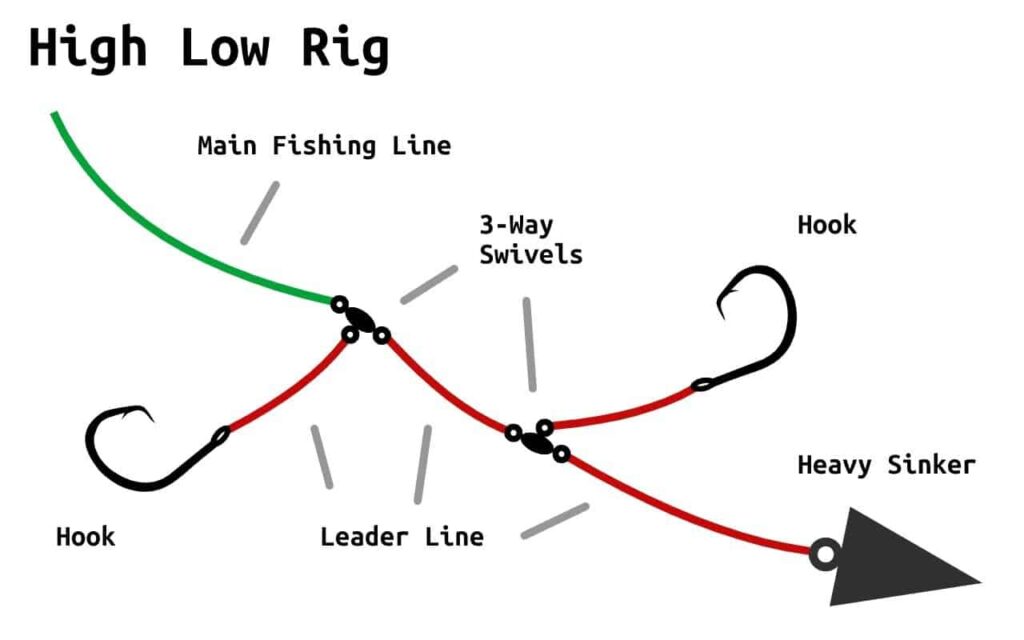
Surf fishing weights can range from egg sinkers for drifting Carolina rigs, to pyramid sinkers, spider weights or breakaway weights for holding your rigs in place against waves and currents.
Bait and Lures for Surf Fishing
The best baits for surf fishing are usually natural baits that matches what the fish are feeding on in the area. Some of the most popular baits are shrimp, squid, sand fleas, crabs, clams, worms, cut bait fish, and live bait fish. You can also use artificial lures, such as spoons, jigs, plugs, soft plastics, and even flies. Yes, you can fly fish in the surf.
The type of bait and lures you use will also depend on the fish you’re targeting. The key is to choose a bait that mimics what the fish are feeding on at the time. Check with local bait and tackle shops for current information on what is working and where to try. By choosing the right fishing rod, fishing line, and bait and lures, you’ll be well on your way to a successful surf fishing trip.
The Best Time for Surf Fishing
The best time for surf fishing is usually during the incoming tide. This is when the water is moving towards the shore, bringing with it baitfish that attract larger predatory fish. But anytime there is good water movement, it’s a good time for surf fishing. Additionally, early morning and late afternoon are prime times for surf fishing as the water is cooler and fish are more active.
Basic Techniques of Surf Fishing
When it comes to surf fishing, there are a few basic techniques that every beginner should know. These techniques will help you catch fish and enjoy the experience of surf fishing. There are 3 basic techniques for surf fishing:
- Casting baits and setting them in place with proper surf weights and waiting for the fish to bite.
- Casting baits with Carolina rigs, or similar, and drifting baits with the current.
- Casting artificial lures with varied retrieves like slow and steady, stop and go, or with a series of short jerks.
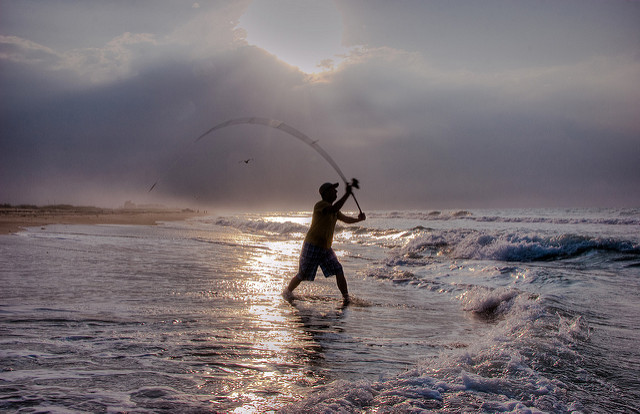
When you feel a bite, you need to set the hook firmly by lifting your rod quickly and reeling in any slack line. Then you need to fight the fish by keeping constant pressure on the line and using your rod as a lever to tire the fish. You may also need to follow the fish along the shore if it runs sideways or towards deeper water.
Surf fishing How to for Beginners: 4 Steps to Reading the Beach
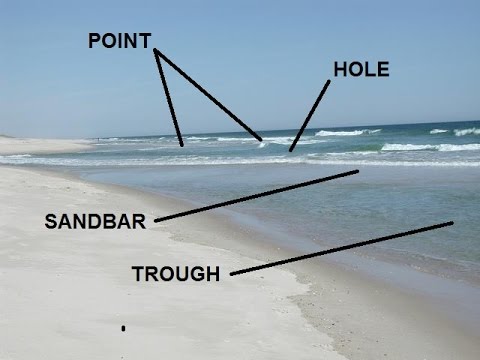
Finding a good spot to surf fish is crucial for success. You need to read the beach and look for signs of fish activity, such as waves breaking, birds diving, bait fish jumping, or darker patches of water. You also need to be aware of the tides and currents, as they affect the movement and feeding habits of fish.
Reading the beach for fishing spots is a skill that can help you find more fish and have more fun. Here are four steps to help you find likely fishing spots for surf fishing:
- First, you need to observe the beach and look for signs of fish activity, such as waves breaking, birds diving, bait fish jumping, or darker patches of water. These indicate that there is some structure or food source that attracts fish.
- Second, you need to identify the different types of structure that create fishing spots on the beach. These include sandbars, troughs, deep-water cuts, points, holes, and runouts. You can use the wave action and water movement to locate these structures, as they cause disruptions or changes in the water depth.
- Third, you need to choose a fishing spot that matches the species you are targeting and the conditions you are fishing in. For example, if you are fishing for pompano or whiting, you may want to fish in the first deep trough near the shore break, where they feed on sand fleas and clams. If you are fishing for redfish, speckled trout, or snook, you may want to fish near a point or a runout, where they ambush bait fish in the current.
- Fourth, you need to adjust your fishing spot according to the tide, wind, and current patterns. Generally, the best time to surf fish is during the incoming tide, especially around sunrise and sunset. However, some species may prefer different tide stages or locations depending on the water level and flow. You also need to consider the wind direction and speed, as they affect the wave size and direction, as well as the water clarity, temperature, and currents.
Surf Fishing for Beginners: Quick Start Basics
Surf fishing is a fun and rewarding way to enjoy the beach and catch some fish at the same time. It doesn’t require a lot of equipment or skill, but there are some tips and tricks that can help you get started.
1. Choose a good spot. Look for areas where the waves break, creating white water and foam. These are the shallower sand bars. The darker water areas between the sand bars are the troughs or guts. This is where fish like to travel and feed on smaller baitfish and crustaceans washed off of the sandbars by the waves and currents. Deep guts close to the beach are good areas to try.
2. Choose the right gear. You’ll need a rod and reel that can handle the saltwater and the distance you want to cast. A 10-12 foot rod with a spinning or conventional reel is a good choice for beginners. You’ll also need some fishing line, rigs or leaders, hooks, sinkers, and bait or lures. You can use live or dead bait, such as shrimp, squid, sand fleas, mullet or other baitfish, or artificial lures, such as spoons, jigs, soft plastics, or plugs.
3. Set up your rig. There are many ways to rig your line for surf fishing, but one of the simplest and most effective is the fish finder rig. This consists of a sliding sinker attached to a swivel, followed by a leader (a short piece of fishing line or wire) and a hook. The sinker slides along the main line, allowing the bait to move naturally with the current. The leader should be about 18-24 inches long, and the hook size should match the size of your bait. For setting baits in one place, a double drop or pompano rig with a spider or sputnik weight is a good choice.
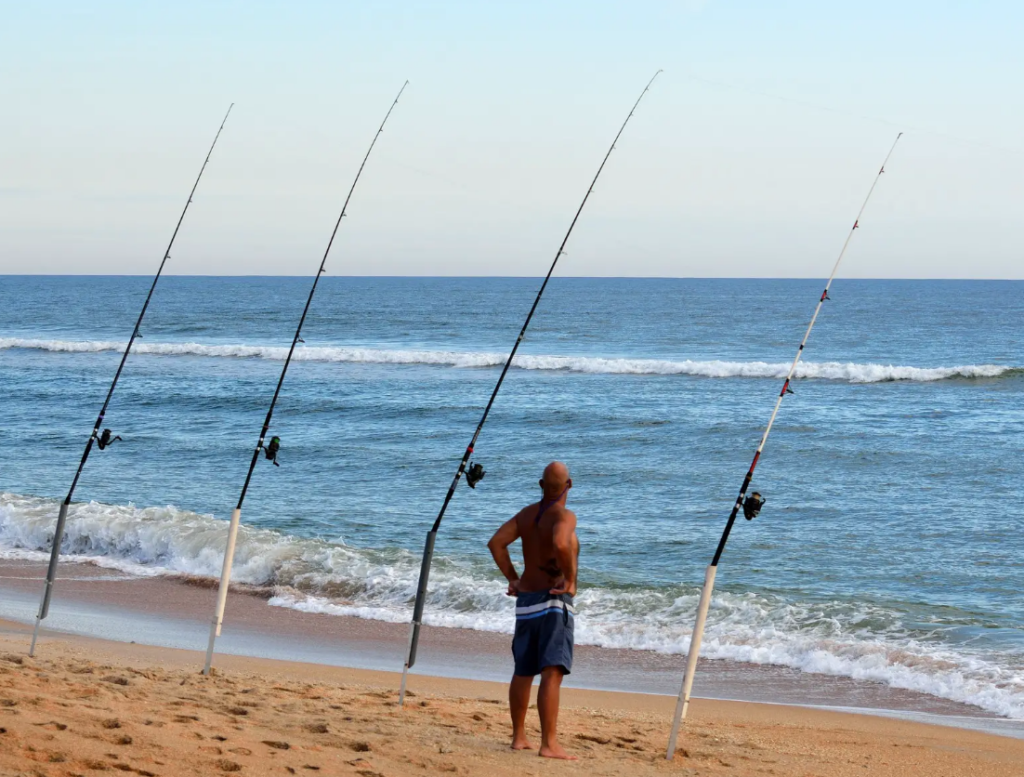
4. Cast your line. Hold your rod with both hands and swing it over your shoulder, then release it when it’s pointing at your target. Aim for the edge of the trough or gut, just inside white water zone of the sandbar, this is where the fish are likely to be feeding.
5. Wait for a bite. Once your line is in the water, you can either hold your rod or place it on a rod holder (a metal or plastic device that sticks into the sand). Keep an eye on your rod tip and feel for any vibrations or tugs on your line. When you get a bite, reel in some slack and set the hook by lifting your rod sharply.
6. Reel in your fish. Once you’ve hooked a fish, keep your rod tip up and apply steady pressure on the reel. Don’t let the line go slack or the fish might throw the hook. If the fish runs or jumps, let it take some line but don’t let it spool you (take all your line). If the fish gets close to the shore, be careful not to drag it on the sand, as this can damage its skin and gills and the hook could pull loose and your fish escape with the next incoming wave. Use a net or a fish gripper to land your fish safely.
7. Enjoy your catch. You can either release your fish back into the water or keep it for eating, depending on the size and species of the fish and the local regulations. Make sure you have a valid fishing license and follow the rules for bag and size limits. If you keep your fish, make sure you clean it properly and store it in a cooler with ice.
8. BE SAFE AND HAVE FUN! Remember, it’s about having fun and enjoying the outdoors. But, waves and currents along the beachfront can knock you down and wash you out to sea in an instant. So, if you will be wading the surf, wear a life jacket. Wear protective footwear to avoid injuries from sharp shells, rocks, or other underwater hazards.
Safety Precautions for Surf Fishing
When it comes to surf fishing, safety should always be a top priority. Surf fishing can be dangerous if you are not careful and prepared. You need to wear appropriate clothing to protect from the sun, wind, and in winter, cold temperatures. And, footwear or waders that can protect your feet underwater hazards like sharp shells, rocks, jelly fish, sea urchins and sting rays.
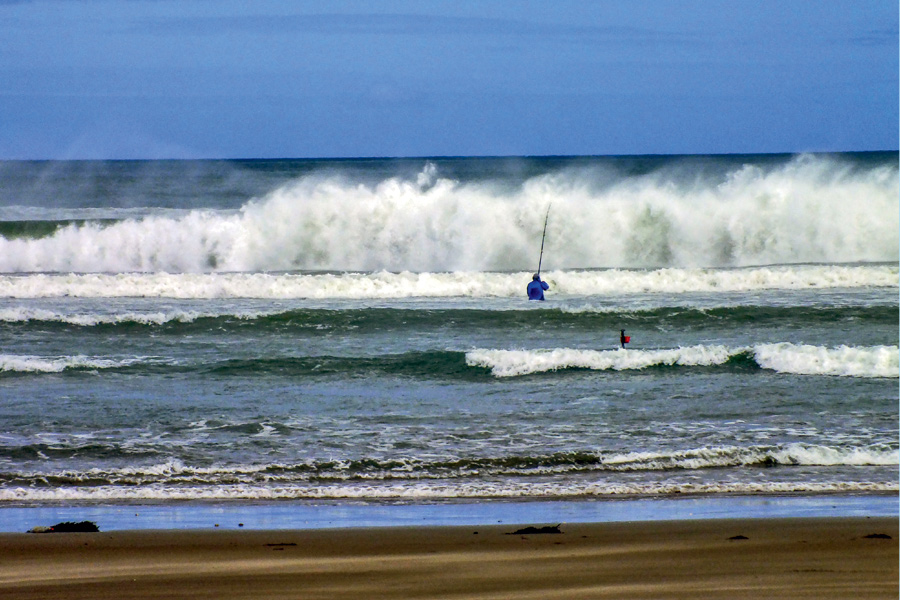
If you are going to be wading the surf, you need to watch out for rip currents, waves, rocks, debris, or other hazards that can sweep you off your feet or injure you. And, it is highly recommended that you wear a life jacket. Remember to respect other anglers and beachgoers by keeping a safe distance from them to avoid and conflicts or interference with swimmers or surfers. You may also want to bring a first aid kit, a flashlight, a knife, a cell phone, or a radio in case of emergency.
Weather Considerations
The weather can play a big role in your safety while surf fishing. Before you head out, make sure to check the forecast and be prepared for any conditions you might encounter. Here are some weather-related safety tips:
- Avoid fishing during thunderstorms or other severe weather conditions.
- Be aware of the tides and the potential for waves to sweep you off your feet.
- Wear appropriate clothing to protect yourself from the sun, wind, and cold.
Maintaining Your Surf Fishing Gear
Surf fishing, and saltwater fishing in general, can be hard on your gear. The marine environment is harsh and very corrosive. To ensure that your fishing gear lasts a long time and performs well, it is important to maintain it properly. Here are some tips on how to maintain your fishing gear:
Rod and Reel: Clean your rod and reel after each use by flushing with plenty of clean fresh water to prevent saltwater corrosion. Use can also use a soft cloth or sponge with mild soap and water, or salt removal product like SaltAway, to wipe down the rod and reel. But be sure to rinse thoroughly with fresh water and dry completely before storing. If you notice any signs of rust or corrosion, use a rust remover to clean the affected areas.
Hooks, Rigs and Lures: Inspect your hooks and lures before each use to ensure that they are in good condition. Rinse them with fresh water and allow them to dry completely before putting them back in your tackle box. Check for rust, bent hooks, or damaged lures. Replace any damaged hooks or lures to avoid losing a fish or damaging your gear.
Line: Check your fishing line for any nicks or abrasions before and after each use. These can weaken the line and cause it to break when you have a fish on the line. If you notice any damage, replace the line before your next fishing trip.
By following these tips, you can ensure that your fishing gear lasts a long time and performs well on every fishing trip.
Conservation and Regulations in Surf Fishing
When it comes to surf fishing, it’s important to follow ethical and legal guidelines to ensure the safety of the fish and the environment. Here are a few things to keep in mind:
Regulations: Before you start fishing, make sure you know the local regulations. This can include restrictions on the size and number of fish you can catch, as well as the type of bait and gear you can use. You should also be aware of any closed seasons or areas where fishing is prohibited. Violating these regulations can result in fines and other penalties.
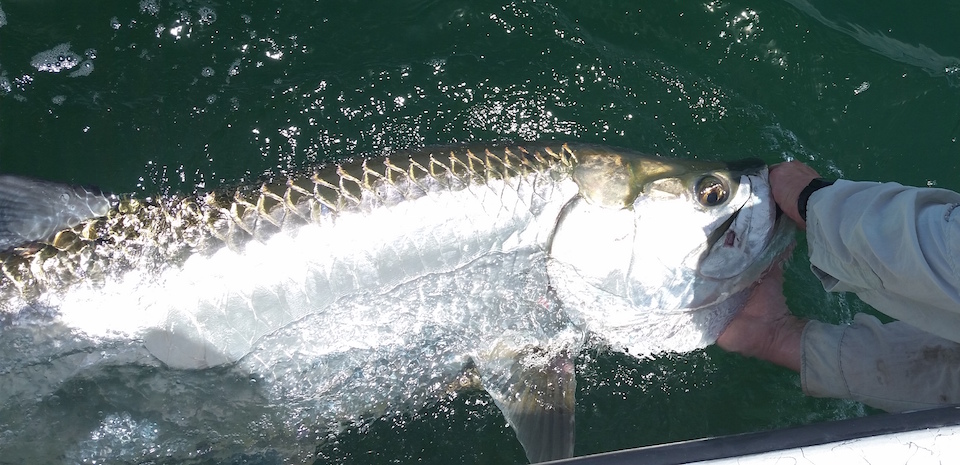
Catch and Release: Many surf fishermen practice catch and release, which involves catching a fish and then releasing it back into the water. This can help preserve the fish population and ensure that future generations can enjoy the sport of fishing. If you do decide to keep a fish, make sure it’s legal to do so and that you have the proper equipment to clean and store it. Remember, keep what you can use, release the rest.
Littering: When surf fishing, or any outdoor activity, please avoid littering. This means properly disposing of all trash, including fishing line, bait containers, and food wrappers. Leaving trash on the beach can harm wildlife and damage the environment. Always pack out what you bring in and leave the beach cleaner than you found it.
Respect for Others: Finally, it’s important to respect other fishermen and beachgoers. This means avoiding crowded areas and giving other fishermen plenty of space. Be on the lookout for swimmers, surfers or jetskiers that could become tangled in your gear. By following these guidelines, you can help ensure that everyone can enjoy their day at the beach and you can experience the thrill of surf fishing.
Surf Fishing How to for Beginners FAQs
What is surf fishing?
Surf fishing is a type of fishing that involves casting a line from the shore into the surf zone, where the waves break and the water is shallow. Surf fishing can be done on any beach, but some beaches are more productive than others depending on the structure, tide, current, wind, and fish activity.

What are the benefits of surf fishing?
Surf fishing has many benefits, such as:
– It is easy and accessible. You don’t need a boat or a license to surf fish. You just need a rod, a reel, some rigs, and some bait or lures.
– It is fun and rewarding. You can catch a variety of fish species, from small ones like whiting and pompano, to big ones like redfish and shark. You can also enjoy the scenery and the atmosphere of the beach while fishing.
– It is challenging and exciting. You never know what you will catch or how big it will be. You have to deal with the waves, the wind, the current, and the fish.
What do I need to start surf fishing?
To start surf fishing, you need some basic gear and equipment, such as:
– A rod and a reel that are suitable for surf fishing. The rod should be long enough to cast far and strong enough to handle big fish. The reel should be durable and resistant to saltwater corrosion.
–Hooks, sinkers, and rigs, that match your bait and target fish. The hooks should be sharp and match the size of your bait. The sinkers should be heavy enough to keep your bait on the bottom, but not too heavy that they hinder your casting distance. The swivels should prevent line twists and tangles.
– Bait or lures that are appealing and realistic to the fish you are targeting. Some of the most popular baits are shrimp, squid, sand fleas, crabs, clams, worms, cut bait, and live bait fish. Some of the most popular lures are spoons, jigs, plugs, soft plastics, and flies.
How do I find a good spot to surf fish?
To find a good spot to surf fish, you need to read the beach and look for signs of fish activity, such as waves breaking, birds diving, bait fish jumping, or darker patches of water. These indicate that there is some structure or food source that attracts fish. You also need to identify the different types of structure that create fishing spots on the beach.
These include sandbars, sloughs, deep-water cuts, points, holes, and runouts. You can use the wave action and water movement to locate these structures, as they cause disruptions or changes in the water depth. You also need to choose a fishing spot that matches the species you are targeting and the conditions you are fishing in.
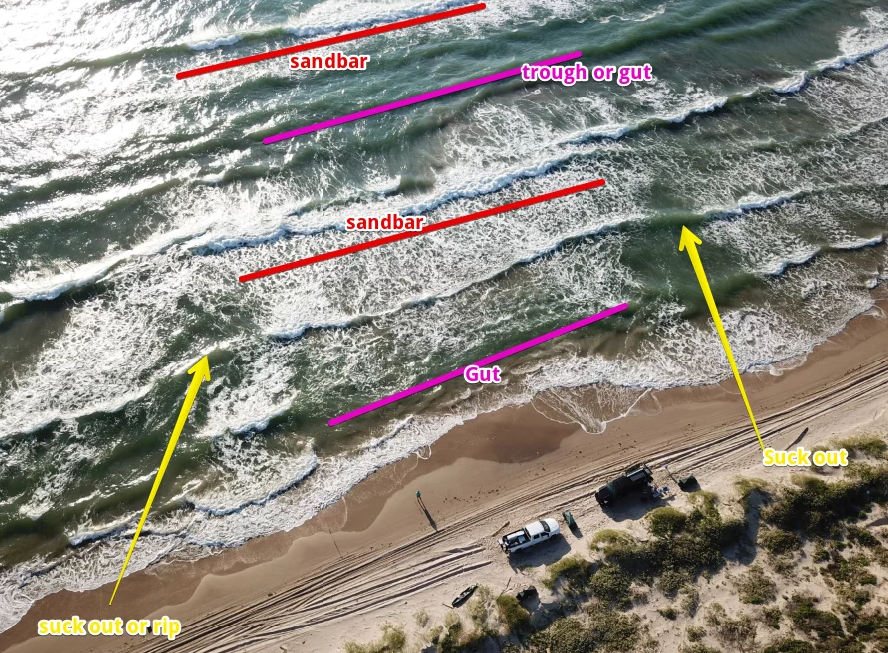
When is the best time to surf fish?
The best time to surf fish depends on many factors, such as tide, current, wind, light, moon phase, season, weather, water temperature, and fish behavior. Generally speaking, The best tide to surf fish is during the incoming tide, when the water level rises and brings more food and oxygen for the fish.
The best rime of day to surf fish is when there is low light or darkness, such as dawn, dusk, night, or overcast days, when the fish are more active and less wary of predators. The best moon phase to surf fish is when there is a full moon or a new moon,when the gravitational pull of the moon creates stronger tides and currents,
How do I catch more fish while surf fishing?
To catch more fish while surf fishing, you need to use the right gear, rigs, bait, and technique for surf fishing. You also need to be patient, persistent, and adaptable to the changing conditions and situations. Here are some tips to help you catch more fish while surf fishing:
– Use a rod and reel that are suitable for surf fishing. The rod should be long enough to cast far and strong enough to handle big fish. The reel should be durable and resistant to saltwater corrosion.
– Use bait or lures that are appealing and realistic to the fish you are targeting. Some of the most popular baits are shrimp, squid, sand fleas, crabs, clams, worms, cut bait, and live bait fish. Some of the most popular lures are spoons, jigs, plugs, soft plastics, and flies.
So, What are You Waiting For? Go Surf Fishing!
Now that you have a good solid foundation on surf fishing, it’s time to plan a trip. I can testify that nothing is as good a teacher as experience. You can read all you want and watch hours and hours of videos, but in the end, you have to get your feet wet and just do it. Start with the basic gear, no need to spend a ton of money starting out, pick a beach and talk to the locals. Then plan a trip and, most importantly, have fun.

Besides a day at the beach is fun for the whole family. You can fish, swim, build sand castles, do some beachcombing.
Or, just enjoy the day relaxing to the sounds of the waves, ocean breezes, and enjoy a cool beverage while watching your rods as the sun sets over the water. Not a bad way to spend a family day, and you might even catch dinner. 😉
As always, stay safe, enjoy the journey and please try to leave it cleaner than you found it. If you have any comments, questions, ideas or suggestions please leave them in the comment section below and I’ll get back to you asap.
You can follow us on Facebook: Rex The Beach Angler, Instagram: thebeachangler7, Twitter: @AnglerBeach, and YouTube: Man Art Creations.
P.S. – Thanks so much for checking out our blog we really appreciate it. Just so you know, we may receive a commission if you click on some of the links that appear on our site. This helps us keep our content free and up-to-date for everyone. We appreciate your support!
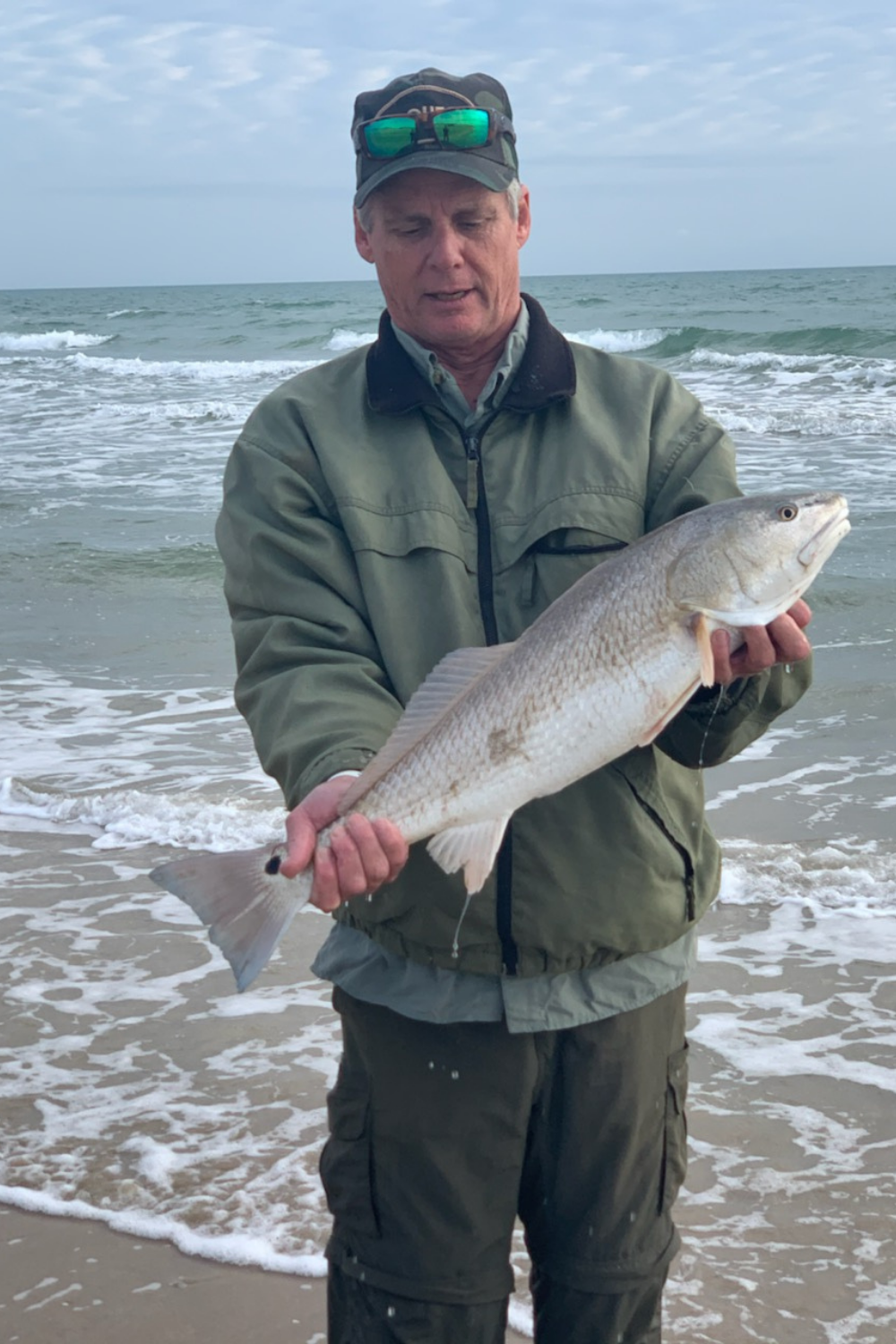
A life long surf fisherman with 50+ years of experience, I am also an avid hunter and outdoorsman. I will be sharing my passion for the outdoors with you so be prepared for hunting, fishing, camping, hiking and more. Along with gear reviews and the latest trends and innovations in the outdoor industry.
